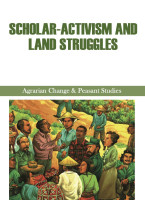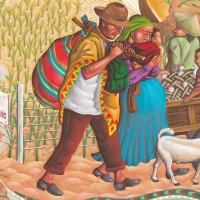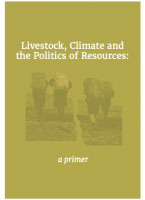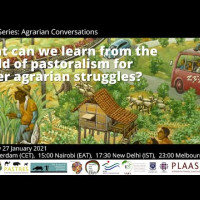The politics of land Introducing an important new collection
Temas
Regiones
Land is central to contemporary debates about politics. Land sustains the livelihoods of millions through farming, livestock keeping, hunting and collecting. Such livelihoods are intimately bound up with nature, and the complex and diverse ecosystems that thrive on land. Land creates a sense of identity refracted through gender, race, class and other axes of difference. Through diverse institutions and forms of authority, land connects citizens and states, corporations and capital, and is the locus of accumulation, extraction and control. Access to land is thus contested, negotiated and claimed through multiple, competing actors, linked to a myriad of struggles. Land, in other words, connects us all through its politics.
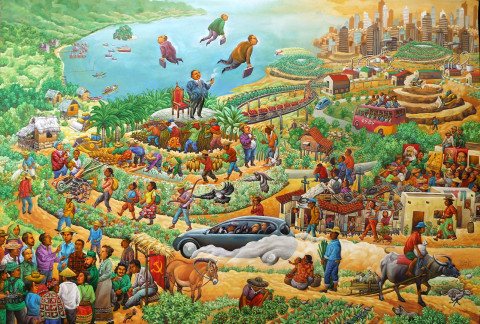
Credit: Federico ‘Boy’ Dominguez
This is why the newly-published Oxford Handbook of Land Politics is so important. Across 38 chapters (880 pages), written by a veritable who’s who of the broad field of critical agrarian studies, the book offers an invaluable guide to these debates, with a stellar overview and introduction from its editors, Jun Borras and Jenny Franco. What follows are some reflections taken from the Foreword that I wrote.
At the end of the Foreword, I ask, what are the new axes of debate, transforming our understandings of agrarian change and politics of land offered in the pages of the Handbook? There are many, but I highlight just four.
- First is the move from seeing land as only a site of production and so accumulation, but also social reproduction, and the locus of highly gendered social and cultural relations. This suggests a much more diverse land politics going beyond class to gender, race, identity and so on. It in turn suggests a renewed focus on labour, with complex livelihoods generated from multiple sources beyond the fixed plot of land, through migration, trade and so on. The classic categories of land-based classes centred only on production are thus unsettled as new forms of livelihood are created. As a result, the dynamics of differentiation and accumulation shifts, with land politics changing as a wider appreciation emerges of Henry Bernstein’s classic questions of agrarian political economy - who owns what, who does what, who gets what and what they do with it?
- Second, the centring of nature, environment and climate in relation to land is a theme that resonates across many chapters. Humans and nature (and so land) are inseparable yet have often become disconnected by the forces of capitalist modernity. The importance of reconnecting is central, requiring a new political ecology/economy of land. This has deep implications for how we see land; again not just as a demarcated plot, but as part of a wider living landscape and territory, within a broader planetary system. This in turn highlights the crucial connection between land and the climate crisis. Changing land use, whether through deforestation, intensive agriculture and extraction of water or minerals is a major contributor to climate change. As the regimes of extraction evolve under new frontiers of capitalism, land is central. Such regimes of food, water and energy are constituted through a contested politics and, as the imperative to switch from fossil fuel dependence and intensive, polluting systems of agriculture accelerates, new challenges emerge. In the rush to ‘net zero’, for example, alternative energy, climate adaptation and nature-based ‘solutions’ are offered, yet all these have implications for who controls the land, with land grabs increasingly justified in the name of green and climate ‘transitions’, which in turn create new land-based politics across the world.
- Third, many chapters argue for going beyond a narrow, individualised approach to land rights, tenure security and land governance. This managerial, administrative and technocratic frame dominates policy thinking but is incompatible with the realities on the ground. As the introduction points out, such efforts to provide ‘security’ for women, Indigenous peoples and others can paradoxically lead to opportunities for dispossession, as speculation, appropriation and extraction increase in areas where ‘regularisation’ has generated legibility through demarcation and delimitation. Instead, there is a need to think about land as constituted through hybrid, mosaic forms of property relation, with property-making as a continuous, contested and negotiated process. Land is always embedded in power relations and so thinking about how authority over land is generated – through interactions between citizens, states, corporations and other actors – can help us elaborate more appropriate democratic institutions for land control and a more innovative, grounded approach to ‘land governance’.
- Finally, the Handbook points to the importance of understanding land as a ‘regime’, situated in a wider historical political economy context. As the introduction highlights, a land regime – just as a food regime - is stabilised, perhaps only tentatively and temporarily, by a set of political-economic forces that operate within a particular phase of capitalism. But regimes change due to the intersection of local struggles and wider political forces and interests. Today these are influenced by new frontiers of extraction and accumulation, linked to globalised economic relations, changing food systems and heightening climate-environment imperatives. Meanwhile, authoritarian, populist regimes define the nation in terms of the relationship between ‘the people’ and their mother/fatherland, always in ways that act to exclude some, while incorporating others in a populist politics of land and belonging. Until we understand this wider historically situated, structural context, the attempts to address the pressing challenges of land and its use at more local levels - whether through moves to agroecology or food sovereignty, for example - will remain elusive.
The Handbook is a rich, diverse and deeply informed collection, mixing theoretical perspectives and grounded reflections. By going beyond a narrow Marxist canon to encompass a wide array of perspectives, no particular line is taken. The introduction encourages readers to find their own way, to read across conceptual framings and reflect on different dimensions – in other words to generate a critical sensibility to agrarian studies and land politics.
For any student of land, or indeed politics more generally, as well as activists and practitioners grappling with the challenges of land politics, this Handbook is an enormously valuable and vital resource.
Links:
The Handbook
The Introduction (Borras and Franco – contact the authors for a copy of the chapter)
The full Foreword (Scoones)(open access)
Note: There are two publication dates mentioned on the website of the Handbook: 2022 was the year when the Handbook project formally got started; 2025 was when the Handbook was actually completed and published as a whole. The online and hardcover editions are aimed at library acquisitions, while a paperback edition is planned for a year or so from now.

